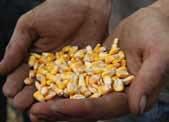While this year’s U.S. corn crop may be smaller than that of a year ago, the quality difference between the two is “night and day,� said Nate Panko, facility manager for Aurora West, a grain terminal operated by the Aurora Cooperative in Aurora, Neb.
“This year’s crop is simply excellent,� Panko said. “Foreign matter is low, moisture came in well and the crop will handle and store well.�
Panko said only 5-10 percent of the crop delivered to the company needed to be run through dryers – and that was generally early harvested corn. The rest, he said, had moisture levels of 14-15 percent or less delivered or dried down in storage through good ventilation. “We saw a lot of No. 2 or better corn come in right off the fields,� he said.
The story from Panko can be repeated in virtually every corn- producing state across the country. Some grain analysts and market watchers believe the 2010 crop may be one of the highest quality crops in history.
Based in Bourbonnais, Ill., Heritage FS grain manager Mike Lambert said corn came out of the fields in Heritage FS’ originating territory at mostly No. 2 – compared to a year ago when much of the corn was No. 3 right off the field. Moisture levels of 20-30 percent were common in 2009 and that creates potential problems from harvest to drying to handling and storage.
For example, wet corn harvested last year needed more force to be removed from the cob than did the dry corn kernels harvested this year. “A year ago, combines had to work hard to bang corn off the cobs,� he said. “At the same time we had to dry and clean the grain, and then clean it again because there was so much foreign matter.�
None of that was the case when it came to harvesting and handling the 2010 crop.
“We’ve seen no problems at all this year. The crop is very nice with strong test weights, low foreign matter and overall very good quality,� he said. “Moisture levels were generally 14-15 percent right of the field and we probably only dried 10-15 percent of the crop early in harvest.�
When corn dries down in the field, Lambert explained, it moves more easily through harvesting, grain handling and other equipment, which helps maintain corn quality through the entire system, including while in storage.


